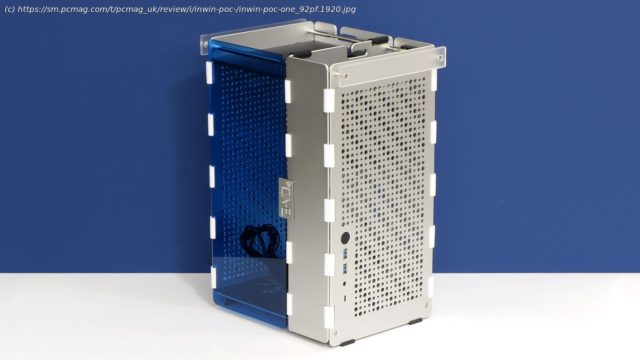Unfold your own tower of power
We’ve seen flatpack PC cases emerge in the last year. So, how about an unfoldable? Assembling your own PC case from panels and parts might be a perfect „extra fun“ task if ordinary PC builds have become mundane. This kind of assembly doesn’t require greater technical knowledge and is hard to do incorrectly. Enter the $239.99 InWin POC One, an upper-crustier version of its earlier, cheaper POC-case-family effort. Building it out is easy; the challenge lies in fitting big components into tiny spaces. If you’re up for it, the POC One might just be your cup of (write in your favorite beverage) if you’re after a vertical-orientation case with a unique semi-industrial look.The Design: Two Back Ends
At roughly half the depth and most of the height of a classic mid-tower, the POC One stands with cases like the SilverStone Alta G1M and Raijintech Ophion Elite in basic layout, apart from one major discrepancy: The power supply mounts on its right side, beneath its exhaust fan mount. The design suggests that you’ll be shoving the thing into a corner, to the right of your keyboard and mouse, which would put its front-panel connectors within easy reach and allow you a good view of its side window.
Those connectors include two USB 3.x Type-A ports, a four-pole headset (headphone/microphone combo) jack and a USB 3.2 Gen 2×2 Type-C, all lined up behind the power button. Those looking a bit more closely at the photo might notice that two of the vent perforations are oval rather than round: That’s a reflection of the 240mm radiator mount on the opposite side. The vents on this side cover the graphics card chamber.
Indeed, on this case, what looks like the bottom is actually the top: While upward-facing port I/O panels are relatively common on small-footprint towers, the POC One is the first we’ve seen to leave that space uncovered, its cable hold-down hooks exposed. With only 1.8 inches of space between the graphics card I/O and the case’s top edge, and an even narrower 1.1-inch gap for motherboard I/O, covering those cable ends would have required a fairly thick 3D panel such as the one seen on the competing Thermaltake The Tower 300. Alternatively, InWin could have flipped the case and made the edges an inch longer. (Or not. Our motherboard and graphics I/O isn’t that ugly.) But know that looking down onto this case from the top will expose all that grisly cabling.
We don’t normally cover the case “unboxing” experience, and sites that do tend to lead with that aspect. But we wanted to get a general description of the case in front of you before discussing how it’s put together. So here goes, and here’s the box.
The POC One’s packaging fairly well violates the idea that shipping the case flat will save on packaging, as it contains as much packaging as most of the big PC cases we’ve tested. We’re talking about two thick layers of box-engulfing closed-cell foam, sandwiched between top and bottom layers of closed-cell foam.
As you can see, the panels are held together and hinged on the long edges with synthetic-material tubes. We’re not sure that looping all the panels together made it any easier to assemble the POC One, compared with the loose panels used in the InWin Airforce or Cooler Master Qube 500. They do make the machine a bit harder to service after the fact, as the window that covers the motherboard compartment (the leftmost panel, below) hangs from the screwed-down panel that allows access above the motherboard, and the same is true for the door that covers the graphics card (the rightmost panel, below).






